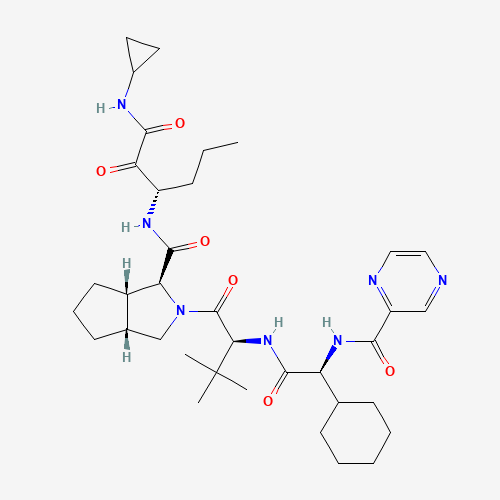| Pharmaceutical Information |
| Drug Name |
Telaprevir |
| Drug ID |
BADD_D02142 |
| Description |
Telaprevir is a direct acting antiviral medication used as part of combination therapy to treat chronic Hepatitis C, an infectious liver disease caused by infection with Hepatitis C Virus (HCV). HCV is a single-stranded RNA virus that is categorized into nine distinct genotypes, with genotype 1 being the most common in the United States, and affecting 72% of all chronic HCV patients [L852]. Treatment options for chronic Hepatitis C have advanced significantly since 2011, with the development of Direct Acting Antivirals (DAAs) such as Telaprevir. Telaprevir is an inhibitor of NS3/4A, a serine protease enzyme, encoded by HCV genotype 1 [FDA Label]. These enzymes are essential for viral replication and serve to cleave the virally encoded polyprotein into mature proteins like NS4A, NS4B, NS5A and NS5B. The barrier for develoment of resistance to NS3/4A inhibitors is lower than that of NS5B inhibitors, another class of DAAs [A19593]. Subtitutions at amino acid positions 155, 156, or 168 are known to confer resistance. The substitutions of the enzyme's catalytic triad consisting of H58, D82, and S139 are also likely to alter the affinity of the drug for NS3/4A or the activity of the enzyme itself. Despite this disadvantage Telaprevir is still effective against HCV when paired with [DB00811], [DB00008], and [DB00022].
Telaprevir, [DB00811], [DB00008], and [DB00022] were used with the intent to cure, or achieve a sustained virologic response (SVR), after 12 weeks of daily administration of the combination therapy followed by 12 or 36 weeks of therapy with [DB00811], [DB00008], and [DB00022]. SVR and eradication of HCV infection is associated with significant long-term health benefits including reduced liver-related damage, improved quality of life, reduced incidence of Hepatocellular Carcinoma, and reduced all-cause mortality [A19626].
Telaprevir was available as a fixed dose product (tradename Incivek) used for the treatment of chronic Hepatitis C. Approved in May 2011 by the FDA, Incivek was indicated for the treatment of HCV genotype 1 in combination with [DB00811], [DB00008], and [DB00022] [FDA Label]. Incivek has since been withdrawn from the market. |
| Indications and Usage |
Telaprevir, when used in combination with [DB00811], [DB00008], and [DB00022] is indicated for use in the treatment of chronic HCV genotype 1 infection in adults [FDA Label]. |
| Marketing Status |
approved; withdrawn |
| ATC Code |
J05AP02 |
| DrugBank ID |
DB05521
|
| KEGG ID |
D09012
|
| MeSH ID |
C486464
|
| PubChem ID |
3010818
|
| TTD Drug ID |
D0X9CH
|
| NDC Product Code |
50370-0034; 66039-899 |
| UNII |
655M5O3W0U
|
| Synonyms |
telaprevir | incivek | VX 950 | VX950 cpd | VX-950 |
|
| Chemical Information |
| Molecular Formula |
C36H53N7O6 |
| CAS Registry Number |
402957-28-2 |
| SMILES |
CCCC(C(=O)C(=O)NC1CC1)NC(=O)C2C3CCCC3CN2C(=O)C(C(C)(C)C)NC(=O)C(C4CCCCC4)NC(=O)C
5=NC=CN=C5 |
| Chemical Structure |

|
|
| ADRs Induced by Drug |
|
|
*The priority for ADR severity classification is based on FAERS assessment, followed by the most severe level in CTCAE rating. If neither is available, it will be displayed as 'Not available'.
**The 'Not Available' level is hidden by default and can be restored by clicking on the legend twice..
|
|
|

